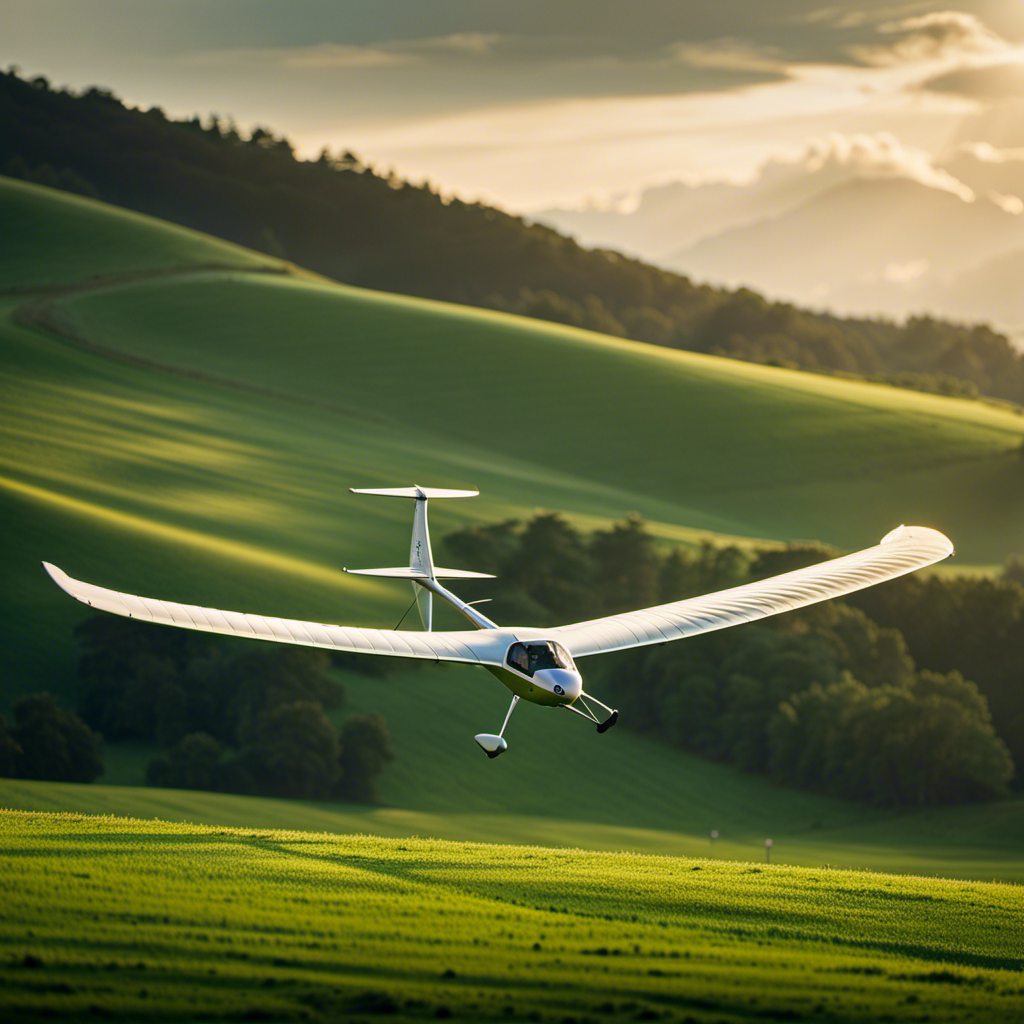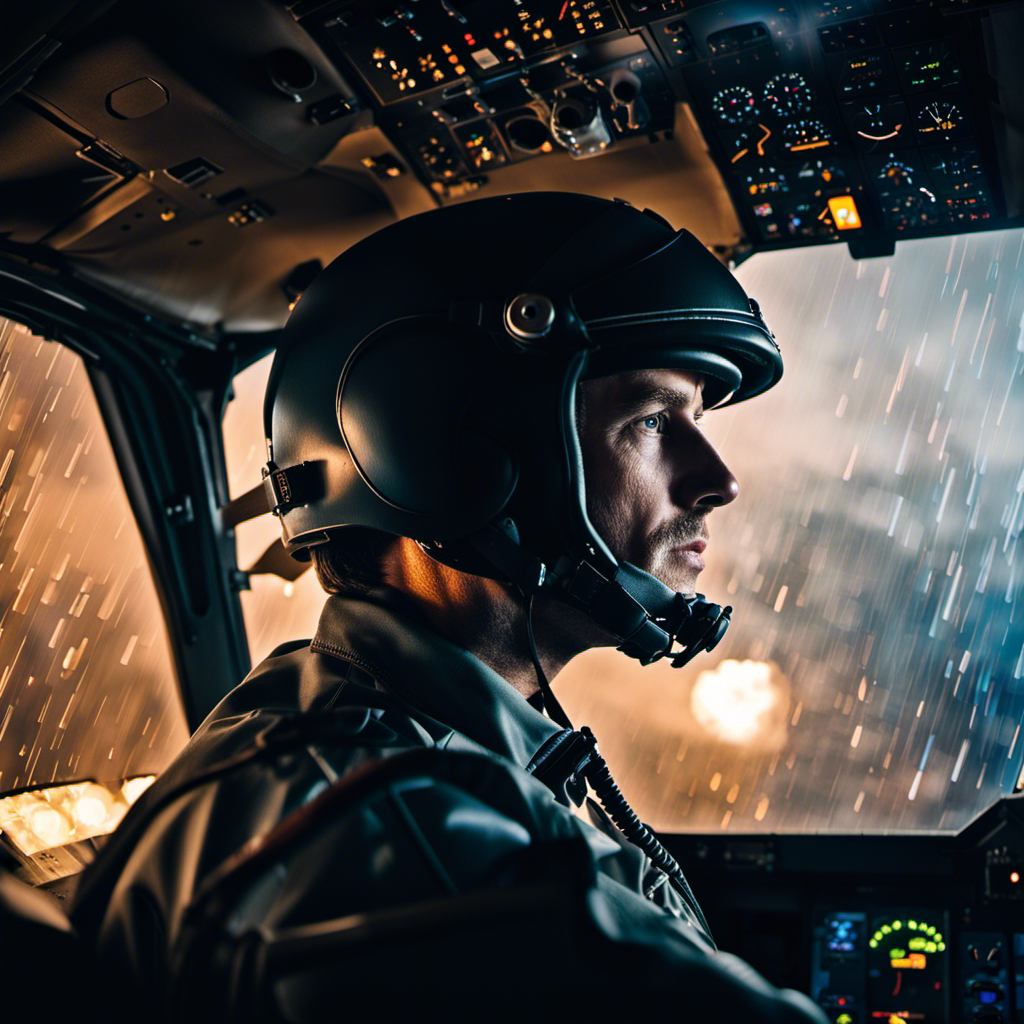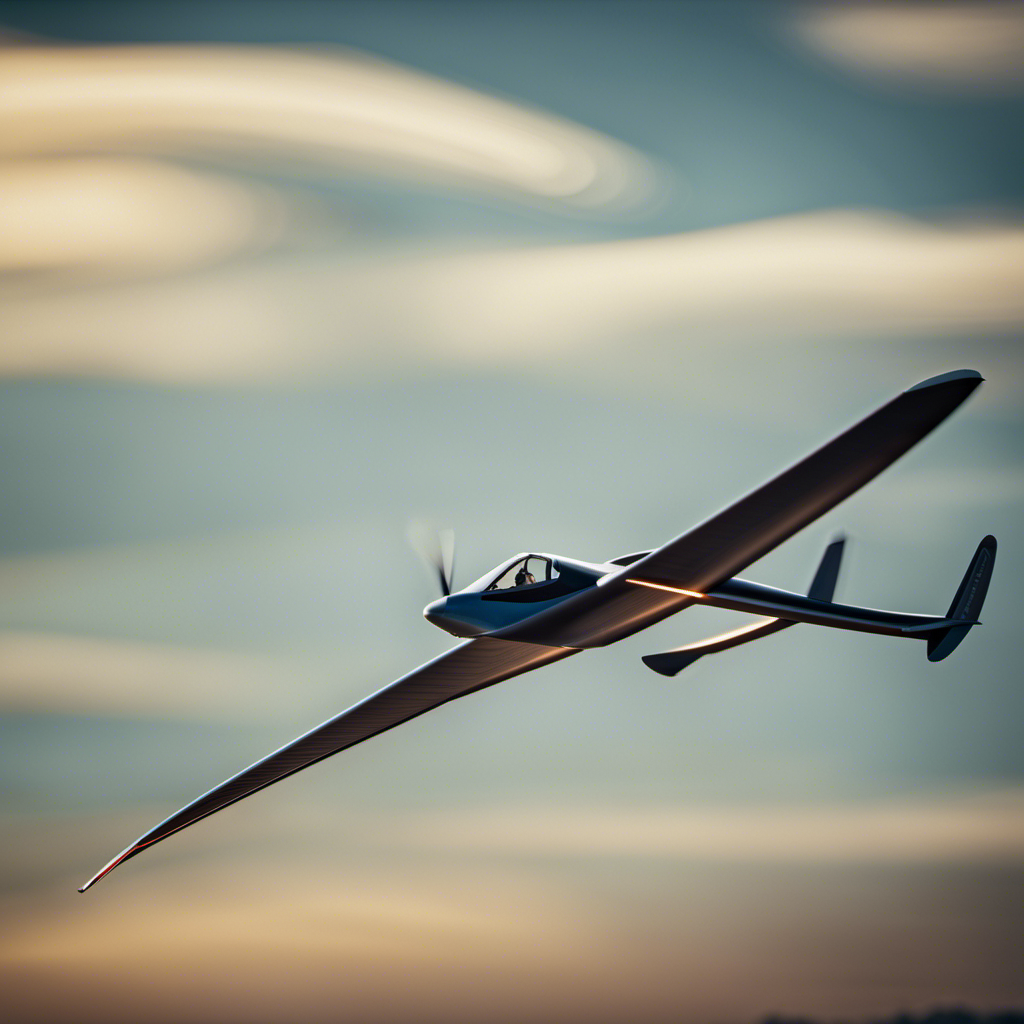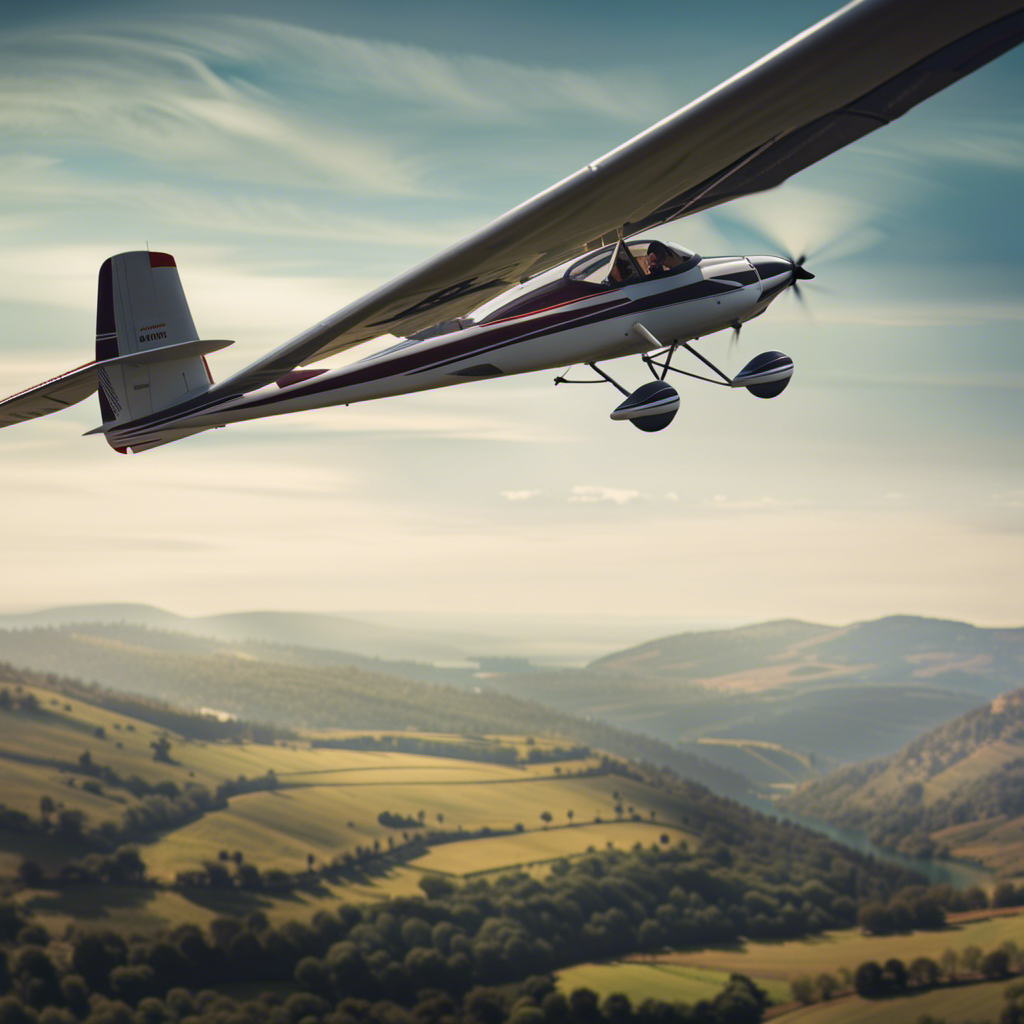As someone who is deeply passionate about glider flying, the art of landing has always fascinated me. Successfully executing a gentle descent to the ground requires a delicate balance of skill, precision, and understanding of flight mechanics.
In this article, I’ll guide you through the process of how gliders land, from setting up the perfect approach to executing a smooth touchdown. We’ll explore techniques like adjusting airspeed, utilizing spoilers and airbrakes, and assessing landing conditions.
So buckle up, because we’re about to dive into the intricacies of glider landings.
Key Takeaways
- Evaluating terrain suitability is essential for safe glider landings, considering factors like slope, surface conditions, obstacles, and wind direction.
- Regular practice of emergency landing procedures is crucial for glider pilots to enhance preparedness and minimize risks during emergencies.
- Proper maintenance of landing gear is important to avoid potential issues during emergency landings.
- Effective communication and coordination with co-pilots or ground crew are vital for successful emergency landings and post-landing procedures.
Understanding the Principles of Glider Flight
Understanding the principles of glider flight helps me know how to control and maneuver my aircraft. Glider aerodynamics play a crucial role in ensuring a safe and efficient flight.
Gliders rely on the forces of lift, weight, thrust, and drag to stay airborne. By manipulating these forces through control surfaces such as ailerons, elevator, and rudder, I can control the glider’s direction and attitude.
Landing gear mechanics are another essential aspect of glider flight. Most gliders have a fixed landing gear, which consists of a sturdy wheel or skid attached to the fuselage. This landing gear helps support the glider during takeoff and landing, providing stability and preventing damage to the aircraft.
Understanding glider aerodynamics and landing gear mechanics enables me to navigate the aircraft effectively and prepare for a smooth landing.
Now, let’s move on to setting up for landing: establishing the proper approach.
Setting Up for Landing: Establishing the Proper Approach
When setting up for landing, you should establish the proper approach to ensure a smooth glider landing. To achieve this, follow these steps:
-
Establishing glide path: This involves determining the correct angle and descent rate to approach the landing area. It is crucial to maintain a gradual descent to avoid a hard landing or overshooting the landing zone.
-
Maintaining proper altitude: It is essential to maintain a consistent altitude while approaching the landing area. This allows for better control and provides enough time to make adjustments if necessary.
-
Monitoring wind conditions: Take into account the direction and strength of the wind to adjust the approach accordingly. Wind can affect the glider’s groundspeed and ground track, so it’s essential to make corrections to maintain accuracy.
-
Utilizing visual references: Make use of visual references, such as landmarks or the runway, to assist in establishing the correct approach. These references help to maintain alignment and determine the appropriate angle of descent.
By establishing the glide path and maintaining proper altitude, you lay the foundation for a successful glider landing.
Now, let’s delve into the next section, where we will discuss adjusting airspeed and angle of descent.
Adjusting Airspeed and Angle of Descent
To achieve a smooth landing, you need to make adjustments to your airspeed and angle of descent.
When approaching the landing area in a glider, it is crucial to manage your descent rate and adjust your glide path accordingly.
To do this, you can control your airspeed by utilizing the glider’s control surfaces, such as the elevator and ailerons. By reducing the airspeed, you can decrease the rate of descent and maintain a controlled approach.
Additionally, adjusting the angle of descent allows you to fine-tune your glide path and ensure that you are on the correct trajectory for landing.
These adjustments are essential in achieving a safe and precise touchdown.
Speaking of touchdown, let’s now move on to the next section where we will discuss the execution of a smooth landing through the flare technique.
Flare and Touchdown: Executing a Smooth Landing
Once you’ve adjusted your airspeed and angle of descent, executing a smooth landing in a glider involves a controlled flare just before touchdown. The importance of proper technique cannot be overstated, as it ensures a safe and efficient landing.
Here are some key points to keep in mind:
- Maintain a stable approach speed, typically around 60-70 km/h, to provide adequate control authority during the flare.
- Gradually reduce the descent rate by gently pulling back on the control stick, raising the nose of the glider.
- As the glider nears the ground, continue to increase the pitch attitude, aiming to level off just inches above the surface.
- At the moment of touchdown, smoothly and decisively release the back pressure on the control stick, allowing the glider to settle onto the ground gently.
Utilizing Spoilers and Airbrakes for Control
You can easily control your glider by utilizing spoilers and airbrakes. Spoilers are panels that can be raised on the wing to disrupt the airflow and reduce lift. They are primarily used to control the descent rate of the glider during landing.
On the other hand, airbrakes are surfaces that can be extended from the wing or fuselage to increase drag and decrease the forward speed of the glider. They are employed to shorten the landing distance and improve control during the final stages of landing.
Both spoilers and airbrakes play a crucial role in glider landing techniques, allowing pilots to achieve precise control and a safe touchdown.
Now, let’s move on to dealing with crosswinds and turbulence.
Dealing with Crosswinds and Turbulence
Transitioning from utilizing spoilers and airbrakes for control, we now move on to dealing with crosswinds and turbulence during glider landings. These are crucial aspects of landing that require careful technique and management to ensure a safe and smooth touchdown.
Here are three important crosswind techniques and turbulence management strategies to consider:
-
Crabbing: When faced with a crosswind, glider pilots use the crabbing technique. This involves aligning the nose of the glider with the direction of the wind while maintaining the desired ground track. It helps counteract the drift caused by the crosswind.
-
Sideslipping: Another technique is sideslipping, which involves intentionally banking the glider into the wind and using rudder input to maintain the desired ground track. This helps to counteract the wind’s effect and maintain control during crosswind landings.
-
Maintaining airspeed: When encountering turbulence during landing, it is essential to maintain a safe airspeed. This helps to prevent sudden changes in lift and control inputs caused by turbulence, ensuring a stable and controlled landing.
Transitioning into the subsequent section about assessing landing conditions and choosing the right landing spot, it is important to carefully evaluate the environment and make informed decisions for a successful landing.
Assessing Landing Conditions and Choosing the Right Landing Spot
Before assessing landing conditions and selecting the ideal landing spot, it’s crucial to carefully evaluate the surrounding environment for a safe and successful touchdown.
Assessing wind conditions is essential to determine the direction and strength of the wind, as it greatly affects the glider’s approach and landing.
Evaluating terrain suitability involves considering factors such as the slope, surface conditions, and obstacles present in the landing area.
The wind direction and terrain suitability are interrelated, as a crosswind landing may require a larger, obstacle-free area.
By carefully analyzing these factors, pilots can identify the most suitable landing spot that minimizes risks and maximizes the chances of a safe touchdown.
With this thorough assessment complete, pilots can then move on to practicing emergency landing procedures to further enhance their preparedness and response in case of unexpected situations.
Practicing Emergency Landing Procedures
To enhance your preparedness and response in case of unexpected situations, it’s important to regularly practice emergency landing procedures. These techniques are crucial for glider pilots to safely land in emergency situations.
Here are three key points to remember when practicing emergency landing procedures:
-
Maintain landing gear: Regular maintenance and inspection of the landing gear is essential to ensure its proper functioning. Check for any signs of wear or damage and address them promptly to avoid any potential issues during an emergency landing.
-
Simulate emergency scenarios: Practice emergency landing procedures in a controlled environment, such as a flight simulator or a designated training area. This allows pilots to familiarize themselves with the necessary actions and develop muscle memory for a smooth execution during real emergencies.
-
Communicate and coordinate: Establish effective communication and coordination with your co-pilot or ground crew during emergency landing drills. Clear and concise communication is crucial to ensure a coordinated effort and maximize the chances of a successful emergency landing.
By regularly practicing these emergency landing techniques and ensuring proper landing gear maintenance, glider pilots can significantly increase their preparedness and response capabilities.
Now, let’s delve into the post-landing procedures and safety considerations.
Post-Landing Procedures and Safety Considerations
Once you have safely touched down, it’s important to promptly secure the glider and assess any potential safety hazards. After landing, it is crucial to follow a post landing checklist to ensure the safety of both yourself and the glider. Maintaining control after landing is of utmost importance, as even a minor mishap can result in significant damage to the aircraft. To help you understand the importance of these procedures, take a look at the table below:
| Post-Landing Checklist | Importance |
|---|---|
| Secure the glider | High |
| Assess safety hazards | Critical |
| Clear the landing area | Essential |
Following this checklist will not only help prevent accidents but also promote a safe flying environment. Now that we have covered post-landing procedures and safety considerations, let’s dive into some tips for improving landing technique and precision.
Tips for Improving Landing Technique and Precision
Improving your landing technique and precision can greatly enhance your overall glider flying experience. To help you refine your landing technique and improve accuracy, here are four key tips:
-
Approach: Maintain a stable glide path and control your airspeed to ensure a smooth descent towards the landing zone. Pay attention to wind direction and adjust your approach accordingly.
-
Flare technique: As you near the ground, initiate the flare by smoothly bringing the nose of the glider up. This reduces your descent rate and allows for a softer touchdown.
-
Timing: Practice timing your flare so that it occurs just above the ground. Too early, and you risk losing altitude too quickly. Too late, and you might touch down too hard.
-
Eyes on the horizon: Focus your gaze on the far end of the runway or landing area. This helps maintain stability and prevents excessive drifting during the landing.
Frequently Asked Questions
How long does it take to learn how to land a glider?
It takes time to learn how to land a glider. The learning curve depends on the individual, but typically involves mastering landing techniques such as approach angles, airspeed control, and flare timing.
Can a glider land on any type of terrain?
Glider landing techniques vary, but yes, gliders can land on uneven surfaces. I once witnessed a glider pilot skillfully navigate a rocky field, using precise control inputs to smoothly touch down. It was a testament to their expertise and the versatility of gliders.
What are the common mistakes to avoid during a glider landing?
During a glider landing, it is important to avoid common mistakes such as misjudging the approach angle, failing to maintain a proper glide path, and neglecting to compensate for wind conditions. These errors can lead to unstable landings and potential accidents.
Are there any specific weather conditions that make glider landings more challenging?
Challenges of glider landings in windy conditions include turbulence, crosswinds, and gusts, which can make it difficult to maintain control and land smoothly. Rain reduces visibility and can create slippery runway conditions, while fog further impairs visibility, making landings even more challenging.
What safety equipment should be worn during a glider landing?
During a glider landing, it is crucial to wear safety equipment such as a helmet, parachute, and harness. These help protect against potential accidents. Additionally, mastering proper landing techniques is essential for a safe and successful touchdown.
Conclusion
In conclusion, glider landings require a combination of skill, precision, and a deep understanding of aerodynamics. By carefully adjusting airspeed and angle of descent, pilots can execute a smooth touchdown, utilizing spoilers and airbrakes for control.
Assessing landing conditions and choosing the right spot is crucial for a safe landing. Additionally, practicing emergency landing procedures and following post-landing procedures ensure the overall safety of the flight.
By continuously improving landing technique and precision, glider pilots can enhance their overall flying experience. Soar through the skies and master the art of glider landings!
With a heart that soars as high as the skies, Aria, affectionately known as “Skylark,” is the driving force behind Soaring Skyways. Her journey into the gliding world began as a young dreamer gazing up at the soaring birds, yearning to experience the weightlessness and freedom they embodied. With years of experience both in the cockpit and behind the scenes, Aria’s commitment to the gliding community is unwavering.










